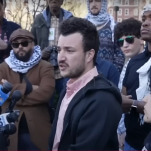'Beautiful Kids': How the Trump Administration Has Weaponized Photographs of Agony
PoliticsThe video is short: in shaky frames, it captures a Syrian boy lying on the ground surrounded by dust and smoke and detritus shortly after barrel bombs were dropped near his home in Idlib, a northwestern province in Syria. The boy wears a sweater, he is in shock, unaware of what has happened to him. As he tries to stand, his shock turns to the sudden realization: his legs have been severed by the bomb; there is nothing left to hold the weight of his small body. He falls back to the ground, reaching to his father, calling to him, “Carry me!”
The boy’s agony, coupled with his desperation and panic, has run through my mind since I watched the video about a month ago after it was shared on social media by a Washington Post reporter. I cannot forget the panic on his dusty face, the small collar poking out from his sweater, his familiar childish demand (“carry me”) cried with such desperation and in the midst of such chaos. It is hard to convey the intensity of the video—hard to capture the boy’s panic; hard to capture his father’s helplessness—without resorting to cliches. Words fail to capture the reality of such moments. To say that the video is horrific or heartbreaking inserts a certain greeting card mawkishness into a visceral, bloody moment. Where words cease, however, the image lingers.
The boy is named Abdel Basit Al-Satouf. Ten days after his home was bombed, he was transferred to a hospital in Turkey where he continues to physically recover from his injuries. The image of Abdel did not “go viral” like so many other images of injured or dead Syrian children. Perhaps it was too graphic. Indeed, in the handful of posts about Abdel and the bombing of Idlib, the video is preceded by warnings and autoplay is turned off (in some, a still simply shows Abdel’s face with white blurs censoring his bloody injuries). Or perhaps it did not have the saintly, meditative quality that virality often demands; perhaps Abdel’s cries for help were too vocal, too resistant to the easy narrative often imposed on photographs. Silence, perhaps, is less painful to process.
Abdel is just one of the numerous children whose suffering we believe we have witnessed; one of many images that have accumulated since the war in Syria began. There are hundreds, perhaps thousands, of similar images; of photographs of Syrian children in pain, suffering the loss of family or limbs or even life. Such photographs are often described as “powerful” and, indeed, it is hard to deny that they are. Such photographs, John Berger wrote in “Photographs of Agony,” are “arresting,” they demand prolonged attention. But where agony intersects with power is a mess of contradictions. The images of Abdel seem to demand a response but they cannot say what that response should be; the images resist answers. Even so, such photographs were offered as evidence, as proof of the need for American force earlier this month. The Trump White House, citing the President’s shock at seeing photographs of the “beautiful… kids,” who were killed or injured during a deadly sarin attack in Khan Sheikhun, turned photographs of agony into a weapon.
“Beautiful… kids,” is an odd turn of phrase. It’s hard to tell if it was a standard, empty Trump iteration or if, more generously, he was simply seeing these kinds of photographs for the first time, since such images from Syria have proliferated in the last five years. If so, he was working hard to avoid looking at them. In 2015, the New York Times published a photograph of a little girl in Douma, her head wrapped in a bright orange bandage, face covered with the white residual dust of destruction punctured by the blood running down her chin. The colors of that photograph—the orange of medical intervention, the white dust, the red blood—rematerialized in a 2016 photograph of Omran Daqneesh sitting dazed in an ambulance after Aleppo was reduced to rubble during a government-led bombing. The photograph of a stunned Daqneesh became yet another visual metaphor for the Syrian war. Multiple news outlets considered the injured boy an icon; on the front page of the Times, his photograph was described as a “symbol of Syrian suffering.”
The photograph of Daqneesh exists in a single frame that tells a singular story, cemented in time by the camera. Images—lives and histories—move outside of the frame but they remain unseen or, at least, unrecorded by a camera’s lens or unpublished in newspapers. The photograph of Daqneesh shows the aftermath of the destruction of the apartment building he lived in with his parents and his siblings but it does not show his reunification with his parents that followed or the death of his 10-year-old brother, Ali. Neither does it show the deaths of five other children who lived in Daqneesh’s apartment complex, the loss of his playmates and neighbors. There are photographs of the destruction of Aleppo, maybe even one or two of the Daqneesh family’s building. We witness the war in temporally disparate, unrelated frames unbound by the lineage of events experienced by those in the photograph.
We believe that we have experienced the agony that we’ve witnessed in the photograph but, of course, we have not. We have only experienced our own indignation.
Photographs of injured children evoke empathy (children, culturally and politically innocent, always do) but that empathy is warped through the very transformation of a child into an image, into an icon. Stuck in time, Daqneesh will always be sitting in the back of an ambulance, his dazed expression will always reflect our own shock back to us. The photograph of Daqneesh has been compared to that of Alan Kurdi, a toddler who drowned off the Turkish coast in 2015 while trying to escape Syria, even though that comparison is not quite right. Like Daqneesh, the photograph of Kurdi offers a viewer a handful of illusions: the boy lies on his stomach, his knees tucked underneath his small body as so many toddlers do as they sleep. In the photograph, Kurdi looks serene. His death in the water, as well as that of most of his family, is erased. Outside of the frame are a series of events unwitnessed by those that mourn over this image: a flight from Syria, an overcrowded boat, and life jackets that didn’t work. What the photographs share is that they are arresting: “We are seized by them,” Berger wrote.
The photographs of Daqneesh and Kurdi go viral for a number of reasons: because they are heartbreaking; because they present the violence in Syria without being too confrontational about the gore; because they are children; because they are silent. Unlike Abdel, they make no direct appeals; response to the photograph becomes the moral dictate of the individual viewer. Photographs of agony, Berger argued, result in either “despair or indignation.”
Despair takes on some of the other’s suffering to no purpose. Indignation demands action. We try to emerge from the moment of the photograph back into our lives. As we do, the contrast is such that the resumption of our lives appears to be a hopelessly inadequate response to what we have just seen.
We believe that we have experienced the agony that we’ve witnessed in the photograph but, of course, we have not. We have only experienced our own indignation. As such, we believe that the photograph makes demands; that the children in these silent images beckon us with words of our own making, demands that assuage our own sense of, in Berger’s words, “personal moral inadequacy.”
-

-

-

-

-

-

-

-

-

-

-

-

-

-

-

-

-

-

-

-

-

-

-

-

-

-

-

-

-

-

-

-

-

-

-

-

-

-

-

-








































